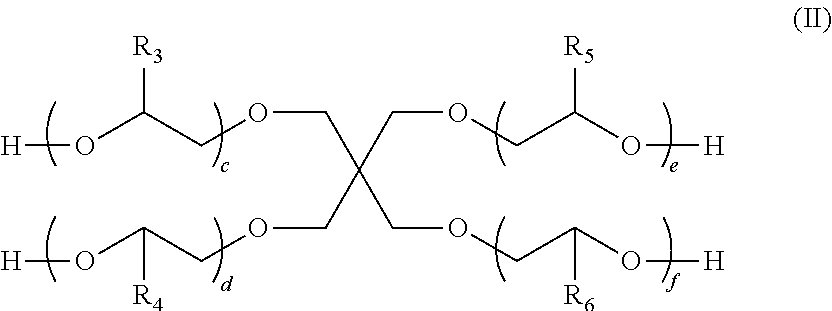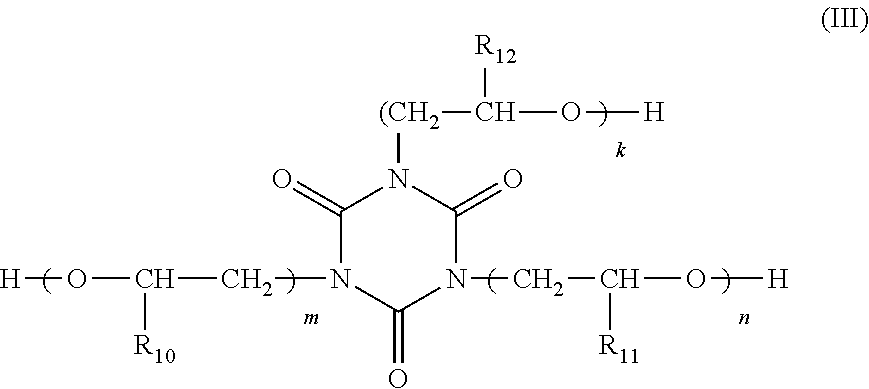Kind of biodegradable polyester and its preparation method
a biodegradable polyester and polyester technology, applied in the field of biodegradable polyester and its preparation, can solve the problems of material degradability, material deformation, material deformation, etc., and achieve the effects of improving the crystallization rate of materials, improving the stability of materials, and changing the softness of polyester materials
- Summary
- Abstract
- Description
- Claims
- Application Information
AI Technical Summary
Benefits of technology
Problems solved by technology
Method used
Image
Examples
implementation example 1
[0070]Add 330 kg 1,5-pentanediol and 175 kg dimethyl terephthalate into the reaction kettle. With the protection of nitrogen gas, increase the temperature to 185° C. Then add 319 g tetrabutyl titanate. Maintain the temperature inside the reaction kettle at 190° C. Add 161 kg azelaic acid after 4 hours' reaction. Allow it to react for 4 hours at 200° C.
[0071]Then increase the temperature to 210° C. After one hour's reaction at low vacuum (90 KPa), add 200 g tetrabutyl titanate. When the temperature reaches 230° C., react for 30 min. Then start to slowly increase the temperature to 245° C. and gradually increase the degree of vacuum to make the pressure inside the kettle reach 1 KPa. Keep the temperature unchanged, and maintain the pressure inside the kettle below 80 Pa. Allow it to react for 3.5 hours to obtain the product.
[0072]The relevant indicators of the obtained product are: molecular weight: Mn=38860, Mw=67500, viscosity: 1.18 dL / g, terminated carboxyl: 50 mol / t, melting point...
implementation example 2
[0073]Add 300 kg 1,4-butanediol, 140 kg dimethyl terephthalate and 640 g glycerin into the reaction kettle. With the protection of nitrogen gas, increase the temperature to 170° C. Then add 350 g tetrabutyl titanate. Maintain the temperature inside the reaction kettle at 190° C. Add 210 kg adipic acid after 4 hours' reaction. Allow it to react for 4 hours at 200° C.
[0074]Then increase the temperature to 210° C. After 1 h 40 min's reaction at low vacuum (90 KPa), add 200 g tetrabutyl titanate. When the temperature reaches 230° C., react for 30 min. Then start to slowly increase the temperature to 245° C. and gradually increase the degree of vacuum to make the pressure inside the kettle reach 1 KPa. Keep the temperature unchanged, and maintain the pressure inside the kettle below 80 Pa. Allow it to react for 3.5 hours to obtain the product.
[0075]The relevant indicators of the obtained product are: molecular weight: Mn=56490, Mw=112850, viscosity: 1.27 dL / g, terminated carboxyl: 75 mol...
implementation example 3
[0076]Add 290 kg isosorbide, 170 kg dimethyl terephthalate and 1200 g trimesic acid into the reaction kettle. With the protection of nitrogen gas, increase the temperature to 180° C. Then add 450 g tetrabutyl titanate. Maintain the temperature inside the reaction kettle at 200° C. Add 170 kg succinic acid after 4.5 hours' reaction. Allow it to react for 4 hours at 210° C. Add 2 kg tri(2-hydroxyethyl) isocyanurate.
[0077]Then increase the temperature to 220° C. After 1 hour's reaction at low vacuum (90 KPa), add 200 g tetrabutyl titanate. When the temperature reaches 230° C., react for 30 min. Then start to slowly increase the temperature to 245° C. and gradually increase the degree of vacuum to make the pressure inside the kettle reach 1 KPa. Keep the temperature unchanged, and maintain the pressure inside the kettle below 80 Pa. Allow it to react for 3.5 hours to obtain the product.
[0078]The relevant indicators of the obtained product are: molecular weight: Mn=49380, Mw=102170, visc...
PUM
| Property | Measurement | Unit |
|---|---|---|
| crystallization temperature | aaaaa | aaaaa |
| solubility | aaaaa | aaaaa |
| temperature | aaaaa | aaaaa |
Abstract
Description
Claims
Application Information
 Login to View More
Login to View More - R&D
- Intellectual Property
- Life Sciences
- Materials
- Tech Scout
- Unparalleled Data Quality
- Higher Quality Content
- 60% Fewer Hallucinations
Browse by: Latest US Patents, China's latest patents, Technical Efficacy Thesaurus, Application Domain, Technology Topic, Popular Technical Reports.
© 2025 PatSnap. All rights reserved.Legal|Privacy policy|Modern Slavery Act Transparency Statement|Sitemap|About US| Contact US: help@patsnap.com



